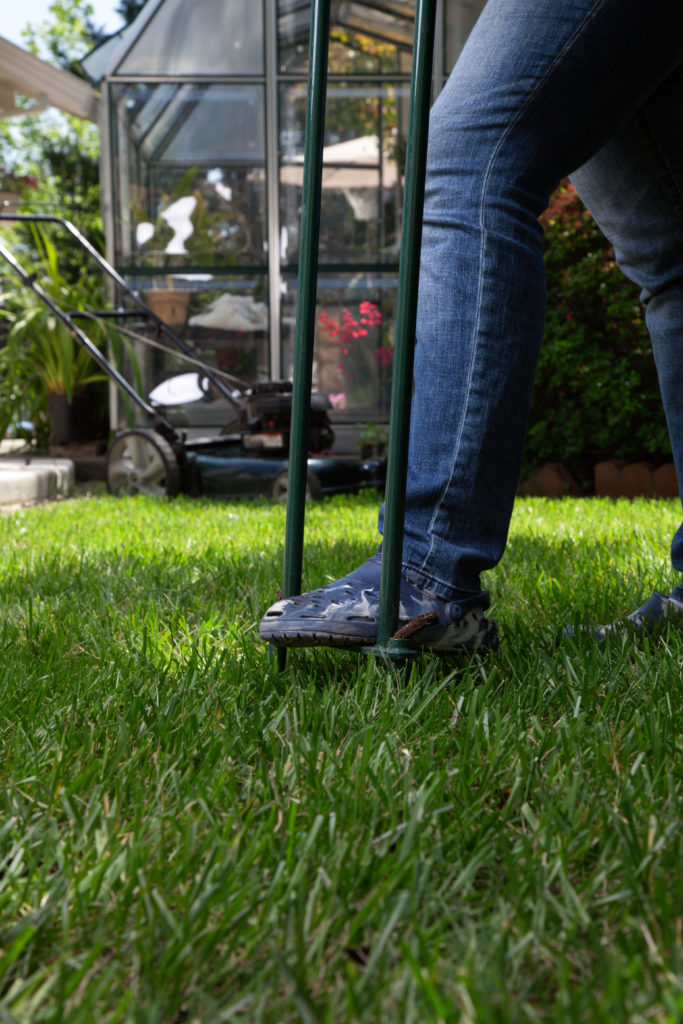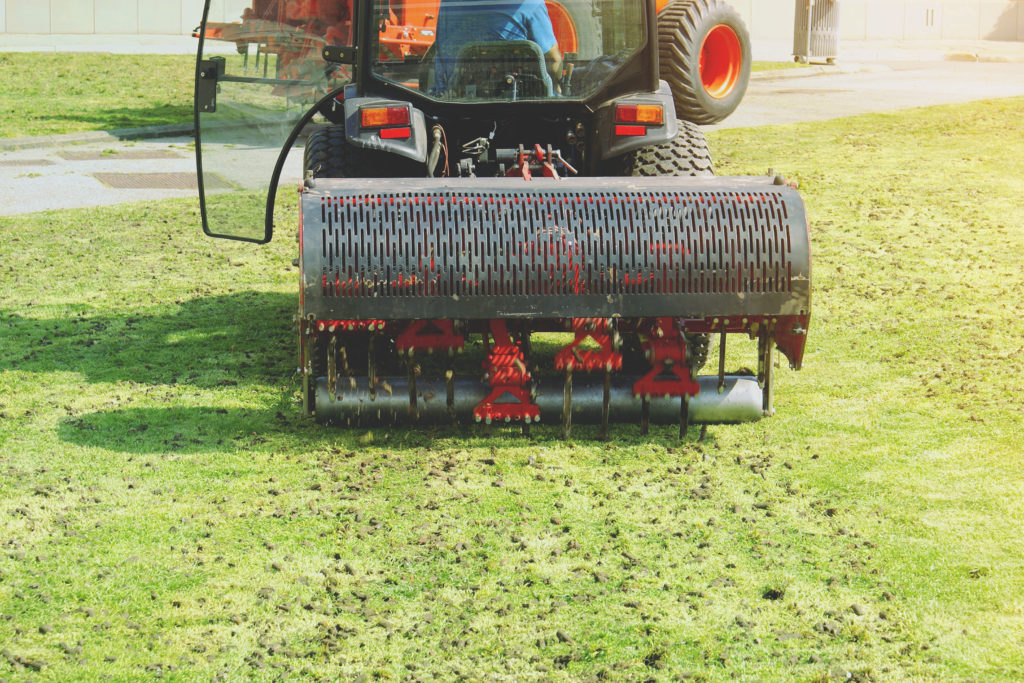Left wondering how to aerate your lawn?
We’ve got the perfect guide to take you through aerating your lawn step-by-step!
Why Is Aerating Your Lawn Important

Do you put a lot of effort into your lawn only to be left scratching your head when it turns brown in the summer? Are you overcome by moss and disease at different times throughout the year?
Whatever your lawn headaches are, you can reduce them with a proper aeration protocol!
But what is aeration? When should you aerate your lawn? What tool is best to aerate your lawn? And finally, why should you do it?
This blog will explain how to aerate your lawn and outline why an aerating program is an absolute must!
Your lawn is a living, breathing organism. Remember that plant someone gifted you for secret Santa last year that quickly withered and died? Your grass follows the same principles of growth.
Just like your plants, grass needs access to oxygen, water, and ample nutrients. It needs oxygen to photosynthesize (turn food into energy) and without it, it will starve itself of the nutrients it needs.
Aerating the grass provides an avenue for not just air but for water and supplements to reach the grassroots.
Mowing your lawn regularly places significant weight on the lawn, compacting it and making it harder for water to penetrate the surface.
Compaction is further increased if you use a reel mower for striping your lawn. Compaction will create uneven runoffs and potentially flood your lawn. Ultimately it’ll impair your lawn’s ability to grow healthily and evenly.
If you were to do one thing other than mowing each year, I would recommend developing an aerating and dethatching protocol for your lawn.
How To Aerate Your Lawn
Now we know why aerating your lawn is important, we now come to what you are most interested in. How to aerate your lawn, when you should aerate your lawn, and what tools are best to aerate your lawn!
If you follow this step-by-step list, you’ll be taking a giant leap forward in maintaining a lush green lawn.
- Make an Aerating & De-thatching Plan
- When to Aerate Your Lawn
- How to Aerate Your Lawn
- Pick the Best Tool For Aerating Your Lawn
Make an Aerating & De-Thatching Plan

The first step to improving the flow of oxygen, water, and nutrients to your grass is to make a plan. Over years of lawn consulting, I have spoken to many customers who tell me they are doing everything for their lawns but just aren’t seeing the results.
What we find is that these customers often have no structure to their lawn care actions. They may be dethatching, watering, and fertilizing, but ultimately, they are doing so at the wrong times.
Unfortunately, life tends to get in the way. The aerating task you set yourself for early spring often ends up being done after the first 2 weeks of hot weather. Your grass is already on the backfoot if this happens!
By setting and following a lawn maintenance plan, you can be confident you’ll be doing the best things for your lawn at the optimum times.
When creating your lawn care calendar, be sure to first understand what type of grass you have. This is extremely important, as depending on where you live, your grass will need different lawn care at different times.
Once you understand what grass you have and what it needs, search for a basic lawn care calendar such as this one from Garden Seeker Lawn Care Calendar.
We would also recommend adding a brief section to your journal, or a garden-specific journal for you to document what works and what doesn’t. By doing so, you can amend your calendar to optimize your lawn care program year after year for a perfect yard.
Top Tip: Search for a lawn care calendar presented by an expert on Youtube who lives in your region and who has the same grass type! Here is one on Fescue.
When To Aerate Your Lawn
Knowing when to aerate is not as easy as many of the other lawn care protocols. For example, for a good look, you want to be mowing at least once a week, taking no more than one-third of the height off your grass.
When to aerate is a bit more ambiguous, many professionals advise autumn aerating, while others, spring aerating. Some suggest light but consistent aerating for most of the year.
Our recommendation is to refer to your individual grass care plan and, most importantly, know the climate you live in and the type of grass on your lawn.
Mild weather climates with a lot of rain are exposed to moss proliferation and a regular year-round aerating program is a worthy use of time. We would advise aerating mid to late spring when the temperature is around 65 degrees Fahrenheit.
A cold winter climate and corresponding grass type require autumn and spring aerating. Do not aerate your lawn in winter if you a susceptible to frosts!
In the winter, your grass goes into a natural dormant state of not growing. By aerating your lawn at this time, you will expose your grass to too much stress and it will not be able to recover. Aerate your lawn in early spring when the temperature reaches 55-60 degrees.
A hot climate requires aerating when the temperatures get to around 80 degrees Fahrenheit. This is normally in late spring or early summer.
How to Aerate Your Lawn
Regardless of what tool you have, coverage is the key to a success when learning how to aerate your lawn. Unlike mowing, where you need to follow straight lines, aerating can be done in any direction in order to maximise the coverage across your whole lawn.
With that being said, the easiest way to cover your whole lawn is to follow a chequered pattern. Whether you are using a manual aerator or a mechanical one, follow these steps;
- Sprinkle some water onto your lawn.
- This will make your life a lot easier as it will be easier for the aerator to puncture the lawns surface. We especially recommend this step if you are using a manual aerator. Do not over water! This could lead to the holes sealing too quickly.
- Start your machine or start to spike your turf between 2 inches (5cm) to 6 inches (15cm) using a spike aerator.
- If you are doing this manually with a garden fork, you can repeat this process every couple of months. For exact timings, refer to Step 2: When to aerate your lawn.
- Seed and Fertilize your Lawn
- Depending on the effect you want, seeding is a good option as you are providing a great avenue for new growth.
- Water your Lawn
- After you finish you finish your aeration and especially if you seed afterwards, sprinkle water across the lawn. Make sure you do not over water as this could cause the holes to seal too quickly.
Pick the Best Tool for Aerating Your Lawn
You’d think this one would be the easiest step of them all but be careful. There are products out there that promise a lot and deliver very little!
Aerating your lawn is a very lengthy process as it involves manually puncturing holes at regular intervals into your lawn.
A good manual aerator will have an inlet in the spikes which will create pulling plugs. As you pull the aerator out of the ground, a plug will be pulled out of the ground. It should drop nicely onto the top of the turf and look a lot like a dear dropping.
You are then left with the task of raking them up or spreading them back into the turf.
We advise mowing your lawn after aerating to break up the plugs and disperse the nutrients in the soil back into the turf.
Many enthusiasts dislike this method because you risk dispersing dormant weed seeds back into your lawn. We much prefer a more organic approach to our lawn care.
The two types of aerators you can purchase are manual aerators and mechanical aerators. We have picked out a few from Amazon and elsewhere to help inform your purchasing decision and show you how to aerate your lawn.
Manual Aerators
As mentioned above, manual aerators take a long time. There are many ways of manually aerating your lawn including using a drill! To keep things simple, here are a few of the main types and our view on which is worth your hard-earned cash.
Aerator Shoes

Don’t waste your money on aerator shoes! In our experience they’re not worth it and will either break, take too long or sit in your shed unused for years.
They are awkward and cumbersome to use and although they are cheap take far too long to complete any reasonable-sized yard.
4 Pronged vs 2 Pronged Aerators

A 4 pronged aerator works okay but with 4 prongs, there is more chance one of them will get stuck in the ground, slowing you down and delaying you further.
We recommend a 2 prong aerator with a plug system. This Yard Butler Manual Coring Aerator is relatively inexpensive and will serve you well for manual aerating
Garden fork
In our experience, the easiest and simple way to aerate your lawn is to use a regular garden fork. Almost everyone has one hidden away somewhere and the forks work very well when used in the correct manner, to aerate lawns.
Check out Tim’s tutorial on using a garden fork to aerate your lawn. Tip: the key is pivoting the forks once in the ground. This allows optimal flow of Oxygen, water and nutrients into the soil and grass roots.
Motor Operated Aerators

Depending on the size of your lawn, we highly recommend purchasing or renting a mechanical aerator. You will be able to rent an aerator from your local hardware store and if you ask your neighbors, you’ll likely find that you can share the cost with them. Kill two birds with one stone where you can!
Alternatively, if you’re serious about lawn care and have a reasonably large sized yard I would advise purchasing an aerator.
Aerating is one of the most time-intensive tasks you can embark on in lawn care. A quality aerator will not only revolutionize the time it takes you to aerate your lawn, but it will also do a better job than you ever could manually.
How To Properly Aerate Your Lawn

We’ve covered a lot of ground – aerated ground! But the key take home is that aerating your lawn is a must! Let’s summarize how to aerate your lawn!
Aerating your lawn is important because it creates an avenue for oxygen, water, and nutrients to reach the grassroots. This allows your grass to breathe and photosynthesize.
Without it, your lawn will not display the results you want for your yard.
The best way to approach aerating your lawn is to first make a plan. You will need to understand your region and the climate that goes along with that region and you will also need to understand your grass type.
With an understanding of your region and grass type, you can then research a calendar to help you with your lawn care.
Use our tips to decide what time of year you’d like to aerate and finally decide on how you would like to aerate (buy a mechanical or electrical aerator! You won’t regret it). Be sure to recognize the difference between an aerator and a de-thatcher!
When you have a good understanding of what type of grass you have and when you should aerate, follow the steps provided in step 3 to aerate your lawn.
Now you know how to aerate your lawn, the next step on your lawn care journey is to understand what thatch in your lawn is and the benefits of dethatching.


